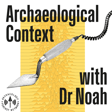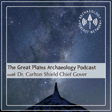
Scythians in the Steppe P2 - The ice maiden from Siberia - With Dr Gino Caspari (S01E03)
This episode is one of the major reasons why I decided to start recording a podcast in the first place. We will remain with prehistoric nomadic steppe tribes, which are attributed to the umbrella term of Scythians, but shift our focus, from present day Ukraine, some 5000 km to the east, to one of the most remote regions on earth, the Siberian region of the Altai mountains. There, over two-thousand-year-old mummies have been discovered, perfectly preserved in ice. These frozen individuals were covered in amazingly detailed tattoos and allowed for remarkable research. So, I hope I’ll be able to give you an account of why I’m so fascinated by these mummies, and then, we’ll continue our conversation with Dr. Gino Caspari and talk about his experiences, excavating grave mounds in remote regions in Siberia.
Reverences:
· Simpson/Pankova Eds. (2017), Scythians. Warriors of ancient Siberia
· Liesowska (2014), Iconic 2,500 year old Siberian princess ‘died from breast cancer’, reveals MRI scan
· Siberian Times (2012), Siberian Princess reveals her 2,500 year old tattoos
· Badenkov (2006), The Frozen tombs of the Altai mountains
· Polosmak (1996), Menschen aus dem Eis Sibiriens
· Rudenko (1970), Frozen Tombs of Siberia
Links: 23minarch.com
Support: patreon.com/23minarch





